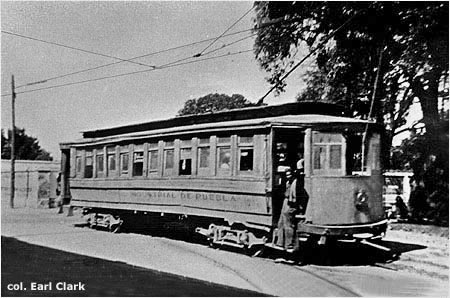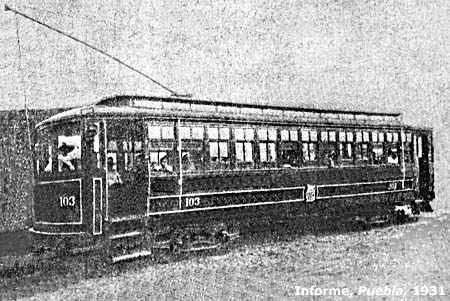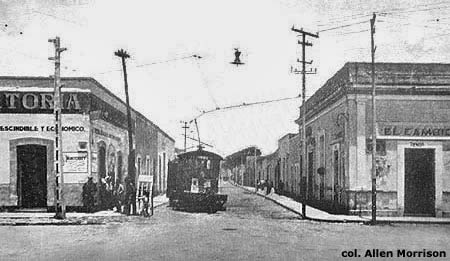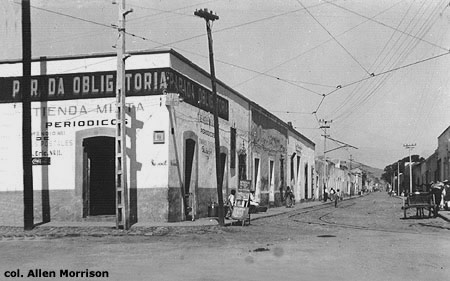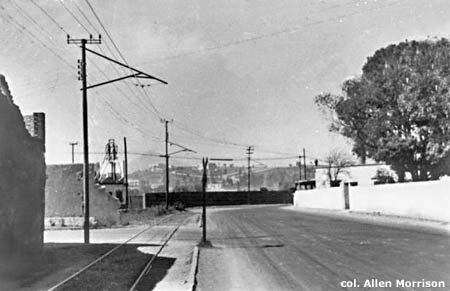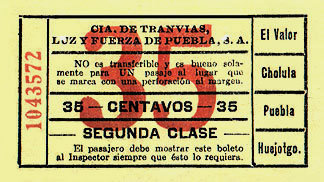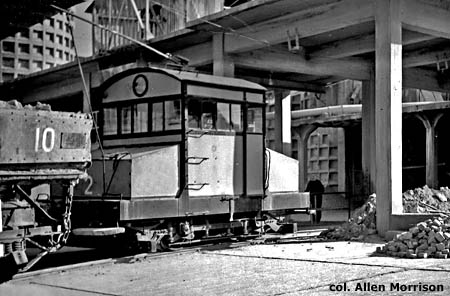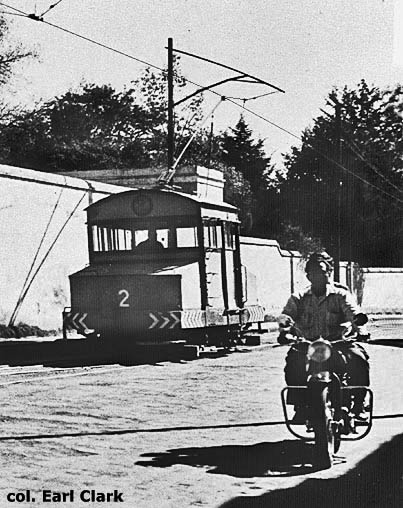The Tramways of Puebla state is Mexico's most mountainous and has its two highest peaks: snow-capped Citlaltépetl (5,610 m), on its border with Veracruz state, and lava-spouting Popocatépetl (5,465 m), which looms over Mexico City at the junction of Puebla, Mexico and Morelos states. Puebla state had a great variety of steam, animal and gasoline-powered railways, but only one commercial electric line. Its capital of the same name, 120 km east of Mexico City (by automobile), was Mexico's second most populous city in 1900, its third in 1920 and is in fourth position today. The Ferrocarril Mexicano reached Puebla in 1869 via Apizaco, 42 km north, where passengers connected with the Mexico City - Veracruz main line. The Ferrocarril Interoceánico later built another route to Mexico City via Cuautla, which was even more circuitous. Because of the rugged terrain there has never been a direct railroad line between Puebla and Mexico City. The city's first horsecars ran on steam railroads that had not yet acquired their locomotives: along the first 4 km of the Ferrocarril Interoceánico in September 1880 – the line was extended to Cholula in 1881 – and along the entire 39 km route of the Ferrocarril de Puebla a San Martín Texmelucán in September 1892 [see map]. Horsepower on the Interoceánico eventually extended 84 km! The Ferrocarril Urbano de Puebla opened the city's first urban horsecar line in May 1881 and by the end of that decade had 20 km of 1435 mm gauge track [postcard, col. AM]:
In
1890 a new company, Ferrocarril Industrial de Puebla, began building
suburban horsecar lines to textile mills at El Valor, Rancho Colorado
and Cholula [see map].
FIP extended the Cholula line 20 km west to Huejotzingo in 1894 and the
El Valor line across the border to Panzacola in Tlaxcala state in 1897.
This was one of Mexico's few interstate horsecar lines.
In 1906 both the FUP and the FIP were absorbed by the new Canadian-owned Compañía de Tranvías, Luz y Fuerza de Puebla (Puebla Tramway, Light & Power Company). CTLyFP joined the Anglo-Mexican Electric group in 1907 and planned to electrify its Puebla lines, but not much progress was made. CTLyFP car 133, below, was typical of its rolling stock for the next two decades [col. AM]:
However, Puebla Tramway replaced some of its mules with gasoline motors: the petrol trams were called "rápidos" or "fordcitos". Note the twin radiators on the car in the front and the roof-mounted gas tank on the tram behind [National Geographic Magazine, Washington, 5/1927, p. 506]:
In 1909 Mexico Tramways Company surveyed a 165-km electric line between Mexico City and Puebla which would have circled Popocatépetl, climbed to an altitude of 4,145 m (13,600 ft) and provided the most spectacular trolley ride on the continent. It would approach Puebla via Cholula. The Revolution intervened and construction stopped at Tulyehualco, 33 km east of Mexico City, in 1912. At the Puebla end, CTLyFP finally electrified its 14 km line to Cholula on 27 May 1924 [see map]. The photograph below shows a car at the loop on the Zócalo in Cholula. The name "FERROCARRIL INDUSTRIAL DE PUEBLA" is partly visible on the side [col. Earl Clark]:
FIP's trolley operation was unusual: (1) it had only four passenger cars; (2) they were unidirectional; (3) their builder is unknown; (4) very few pictures of them exist; (5) the single-track line had only one passing siding; (6) the wire brackets were of an odd design not seen anywhere else. The car in the photograph below has a "CTLyFP" emblem on its side. Puebla's electric trams were numbered 101-104 [Informe, 1931: see BIBLIOGRAPHY below; the author is looking for a better copy of this photograph]:
Both cars in the photos above have Brill model 76 trucks. The car design and the trucks date from the first years of the century, but no order for such vehicles could be found in records in the United States. It seems likely that these are secondhand trams from Mexico City - perhaps cars that were specially designed or rebuilt for the 165-km intercity line that never was. There seem to be no other photos of the passenger cars, but the picture below shows an FIP freight motor about to turn north off Av. Morelos in Cholula [see map]. In addition to the textile mills, FIP served a quarry near Puebla called Cementos Atoyac [Guillermo Bonfil Batalla, Cholula, México 1973, photo section between pp. 138 & 139]:
The postcard view below shows the same corner in Cholula a few years later. The "PARADA OBLIGATORIA" shop, which published the postcard, is named for the "required stop" on the streetcar line. Note the peculiar wire bracket and the trees of the Zócalo - the tramway terminus - in the distance [col. AM]:
The photograph below shows an unidentified section of the Puebla-Cholula electric line [col. AM]:
On 3 April 1928 CTLyFP eliminated its rail division and the remaining tram routes were transferred to the Puebla state government. The latter closed the gasoline tramway from Cholula to Huejotzingo and extended the tram route in Puebla from the carbarn on Calle 11 to a new "Y" on Calle 5 [see map]. From 12 October 1930 Cholula electric cars and El Valor gas trams used a terminus closer to the city center. Passenger service on the Cholula line continued through 31 December 1941. The last petrol tram ran to El Valor three months later. After the FIP system closed, Cementos Atoyac continued to transport its produce along 3 km of the Cholula line from the Puebla railroad station to its quarry [see map]. Here is a locomotive in its shops [col. AM]:
This practice continued for 22 years - longer than passenger trolleys had run to Cholula! The photograph below was taken on Av. Reforma in 1962. The strange wire hangers are still there. All rail service ended in 1963 [col. AM]:
The other electric railway in Puebla state was a 35 km private line operated by the Mexican Light & Power Co. between the Beristain terminus of the Hidalgo Railroad and its hydroelectric plant at Necaxa, near Huauchinango. In addition to numerous hacienda lines, there were also animal-powered tramways in Atlixco, Atotonilco, Ciudad Serdán (formerly Chalchicomula), Guadalupe, San Miguel Espejo, Sesma, Tehuacán, between Tehuacán and Esperanza, Tepeaca, Texmelucán, Tezuitlán and Zacatepec.
BIBLIOGRAPHY (in order of publication) Frederick A. Ober. Travels in Mexico and life among the Mexicans. St. Louis, 1883. Interesting references to Puebla horsecars, pp. 507-508. Luis G. Careaga y Saenz. Plano Topográfico de la Ciudad de Puebla. México, 1883. Early street map shows tramway and railroad lines in detail. Secretaría de Comunicaciones y Obras Públicas. Carta del Ferrocarril Industrial de Puebla. México, 1894-. Various editions show the development of the suburban tramways. "Car Equipment for Puebla, Mexico" in Street Railway Journal (New York), 19 August 1905, p. 277. Description and photo of horsecar built by American Car. Co. for "F.C. Urbano de Puebla". "The Puebla Tramway, Light and Power Company" in The South American Journal (London), 11/11/1922, p. 388. Detailed description of the company's operations and finances. Puebla (state). Gobernador. Informe rendido por el C. Gobernador Constitucional del Estado, Dr. Leonides Andreu Almazán, ante la Honorable XXIX Legislatura de Puebla. Puebla, 1930-1931. Rare illustrations and data on the Ferrocarril Industrial, especially on pp. 108-121 of the "Enero de 1931" edition. Enrique Cordero y T. Crónicas de mi Ciudad. Puebla, 1946. Memories of mule and petrol trams in the chapter "Los Tranvías de mulitas", pp. 170-173. No mention of electric trams! Luis León Torrealba. "Puebla-Cholula Interurban" in Short Circuit Bulletin (San Antonio), n.d. [1961]. Map and five paragraphs about the Cementos Atoyac line. Luz María Josefina Walles Morales. Cholula. Puebla, 1971. Interesting tramway chronology, pp. 196-198. Guillermo Bonfil Batalla. Cholula. Mexico City, 1973. Photo of trolley freight in Cholula, p. 00. Francisco Garma Franco. Railroads in Mexico: An Illustrated History. 2 vols., Denver, 1985 & 1988. Translation by Hector Lara Hernández and Ben B. Massie of the author's unpublished manuscript. Notes about horsetram operation on the San Martín Texmelucán line in vol. II, p. 147; and on the Izúcar de Matamoros (Interoceánico) line in vol. II, pp. 165-166. Gloria Tirado Villegas. "Tranvías, el transporte moderno" in Enlaces (Puebla) no. 1 (Julio-Septiembre 1994), pp. 10-15. Concise survey of early tramway development. Gloria Tirado Villegas. Entre la rienda y el volante. Puebla, 1996. Nice 142-page history of Puebla transportation "from the rein to the steering wheel".
return to Copyright © 2003-2103 Allen Morrison - ALL RIGHTS RESERVED |



